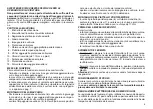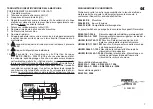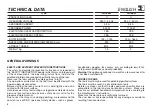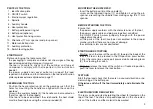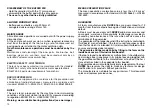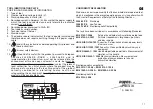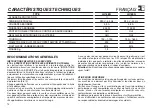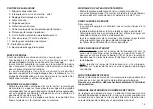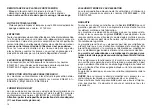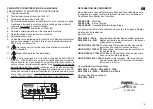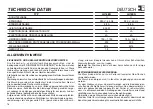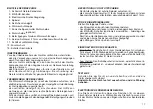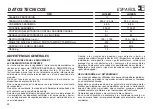
9
PARTS OF THE TOOL
1 - Identification plate
2 - ON/OFF switch
3 - Electronic rpm regulation
4 - Spindle
5 - Auxiliary handle
6 - Heat protection
7 - Buffer pad tapered ring nut
8 - Buffer pad (optional)
9 - Heat protection fixing screws
10 - Wrenches (17 mm spanner and pin spanner)
11 - Motor ventilation slots
12 - Auxiliary protection
13 - Switch locking button
STARTING UP
Before starting-up the tool ensure that:
- the packaging is complete and does not show signs of having
been damaged during storage or transport;
- the tool is complete; check that the number and type of
components comply with that reported in this instruction
booklet;
- the power supply and socket outlet can support the load
reported in the table and that indicated on the tool identification
plate reproduced and explained on page 11.
ASSEMBLING THE TOOL
- Position the heat protection (6) on the gearbox such that the
holes for mounting the handle are aligned with those on the
gearbox;
- screw in the auxiliary handle (5); the handle can be mounted on
the left or right of the tool body;
- if the tool is to be used without the side handle, the heat shield
must be fixed in place using the screws provided (9).
MOUNTING THE BUFFER PAD
- Insert the buffer pad (8) on the spindle (4);
- screw on the tapered ring nut (7) and tighten it using the pin
spanner, preventing the spindle from moving using the 17 mm
spanner.
BEFORE STARTING THE TOOL
Ensure that:
- the power supply conforms with the characteristics of the tool;
- the power supply cable and plug are in perfect condition;
- the ON/OFF switch works properly though with the power
supply disconnected;
- all the parts of the tool have been assembled in the proper
manner and that there are no signs of damage;
- the ventilation slots are not obstructed.
STARTING AND STOPPING
- Starting: push the lever of the switch (2) fowards the body of the
tool; if the tool is to be locked in the ON position, press button
(13) at the same time and keep it pressed while releasing lever
(2), thus locking the switch.
- Stopping: release the lever of the switch or, if locked in position,
push the lever to release the lock button.
TEST RUN
Start the tool and check that there are no unusual vibration, or no
dismatching of the buffer pad.
Otherwise switch-off the tool immediately and eliminate the
fault.
ELECTRONIC RPM REGULATION
The rpm can be adjusted by rotating the wheel (3) located on the
top of the tool. The choice of speed depends on the characteri-
stics of the buffers and the material to be worked.
Summary of Contents for LH16EN
Page 29: ...1 2 3 4 5 6 7 8 9 10 17 11 12 13 31 6 5 9 8 4 7 17 2 13 2 3 29...
Page 32: ......





